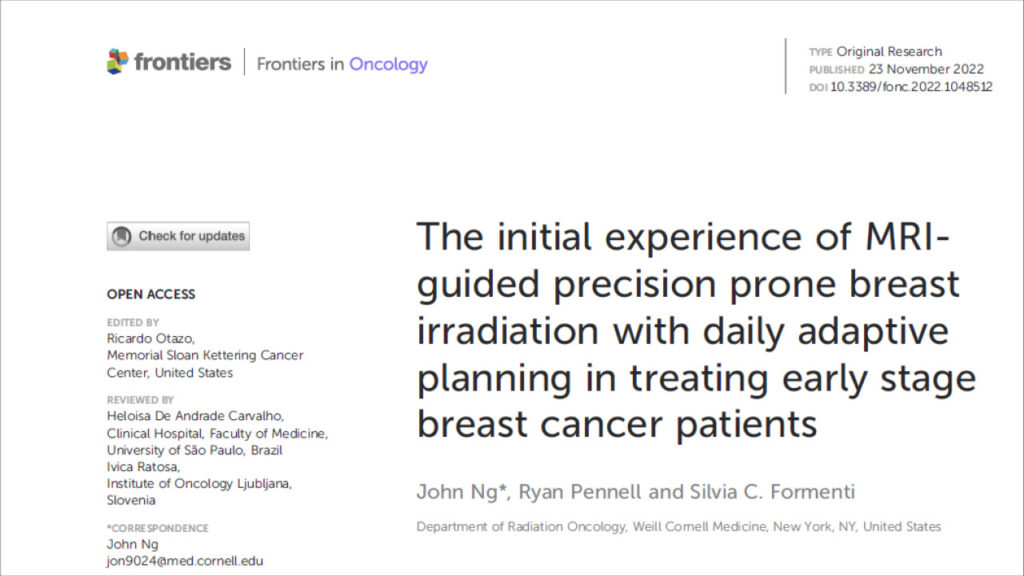MRIdian SMART for Breast Cancer
For Patients

Reduce the number of visits. Excellent cosmesis.
Breast cancer is the leading cancer diagnosis in U.S. women and the second most common cancer in women worldwide.1 While survival rates continue to climb, the quality of life for women undergoing treatment and the impact both to their families and the economy cannot be underestimated.
While conventional radiation therapy is generally delivered to whole breast over the course of five to six weeks. MRIdian makes it possible to:
- Reduced burden on the patient, with fewer treatments: therapy can be completed in 1 week vs. 4-6 weeks, with 1-10 fractions and the same cosmesis outcomes as conventional therapy.2,3,4
- Treat partial breast with very high doses in few sessions with excellent cosmesis.2,3,4
- Visualize the resection cavity during setup and for real-time tracking and beam gating, with high-contrast, high-resolution MR soft tissue imaging.2,3,4
- Greater clinical confidence in treating partial breast with very high doses in few sessions while achieving:
- Excellent cosmesis.2,3,4
- Decreased PTV volumes with 0-1cm PTV margins — half what is typical with standard radiotherapy.2,3,4
- Provide patients an alternative to mastectomy.2,3,4
For Important Safety Information click here

For Important Safety Information click here
Noteworthy Clinical Findings*
- No grade 3-5 toxicities observed
- 100% excellent to good cosmesis reported by both patients and treating physicians
- Patient-reported quality of life did not decrease after treatment
- Excellent early local, regional, and distant control rates
*Kennedy et al. (2020), was published in the February issue of the International Journal of Radiation Oncology * Biology * Physics.
Clinical Resources
To learn more about ongoing clinical trials for breast cancer, visit our Clinical Trials page.
Where can I go for more information?
Please contact your healthcare provider with any questions or concerns.
Important Safety Information
Indications for Use (IFU): The
MRIdian Linac system, with magnetic resonance imaging capabilities, is intended
to provide stereotactic radiosurgery and precision radiotherapy for lesions,
tumors, and conditions anywhere in the body where radiation treatment is
indicated. The MRIdian Linac System is not appropriate for all patients,
including those who are not candidates for magnetic resonance imaging.
Important Safety Information (ISI):
Radiation treatments may cause side effects that can vary depending on the part
of the body being treated. The most frequent ones are typically temporary and
may include, but are not limited to, irritation to the respiratory, digestive,
urinary or reproductive systems; fatigue; nausea; skin irritation; and hair loss.
In some patients, side effects can be severe. Treatment sessions may vary in
complexity and duration.
Radiation treatment is not appropriate for all cancers. You
should discuss the potential for side effects and their severity as well as the
benefits of radiation and magnetic resonance imaging with your doctor to make
sure radiation treatment is right for you.
Disclaimer: The opinions and
clinical experiences presented herein are specific to the featured physicians
and the featured patients and are for information purposes only. Nothing in
this material is intended to provide specific medical advice or to take the
place of written law or regulations. Results of treatment presented in the
videos and information on this webpage are not indicative of typical or future
results.
Discuss treatment options with your doctor,
including the risks and benefits of the entire course of treatment specific to
your individual needs. MRIdian Linac systems are only available at
appropriately equipped facilities with specially trained physicians.
Citations
1. Ferlay, J., et al. (2018). Global Cancer Observatory: Cancer Today. Lyon, France: International Agency for Research on Cancer. Retrieved August 30, 2019 from https://gco.iarc.fr/today
2. Kennedy, W. R., Thomas, M. A., Stanley, J. A., Luo, J., Ochoa, L. L., Clifton, K. K., et al. (2020). Single institution phase 1/2 prospective clinical trial of single-fraction, high-gradient adjuvant partial-breast irradiation for hormone-sensitive stage 0-I breast cancer. International Journal of Radiation Oncology * Biology * Physics. 107(2): 344-352. doi:10.1016/j.ijrobp.2020.02.021
3. Zoberi, I. Physician Experience with MR Image-Guided RT for Breast Cancer. (2018) Industry Expert Theater Presentation at ASTRO 2018, San Francisco, CA. https://vimeo.com/300878157#t=980 Accessed Nov 19, 2020.
4. Zoberi, I, Thomas, M.A., Curcuru, A., Green , O.L., Ochoa, L.L., Kashan, R. (2016). First-ever magnetic resonance image-guided radiation therapy for accelerated partial breast irradiation: early results of a single institution′s prospective experience. International Journal of Oncology * Biology * Physics. Poster Viewing Abstract 96(2)sppl: E47.



